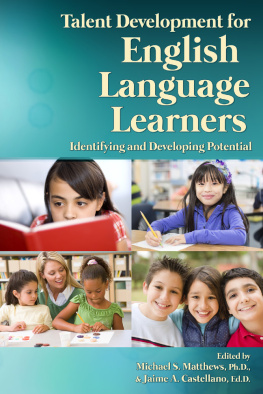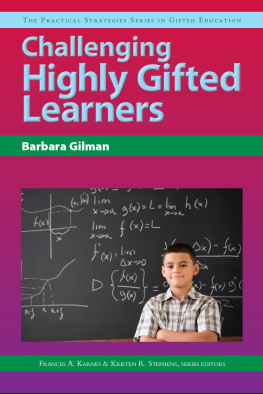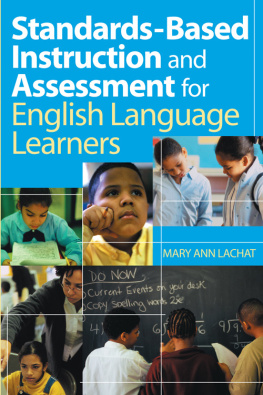Acknowledgments
Many people have contributed to the development of this volume. In addition to acknowledging the strong contributions by the authors of each chapter, we would like to acknowledge the many scholars and classroom teachers on whose work and experience we have based our recommendations. Collaborative effort that draws from and builds upon prior learning is how we allwhether teacher, scholar, administrator, or studentadvance the development of talents and interests in ourselves and in others.
Paul Matthews was the mover and shaker behind the initial proposal for this book, but had to step aside when his job responsibilities changed. Fortunately, he was able to contribute an excellent chapter on service learning. Vicki Krugman also contributed to the initial proposal for the book, and she went on to contribute a chapter (with Linda Iza) despite taking her retirement during the early stages of the project.
Jaime Castellano, whom I have known since we presented together in a shared session at the National Association for Gifted Childrens annual convention in Atlanta in 2000, has been an invaluable contributor as my co-editor. Thank you Jaime for lending your considerable expertise to this book! It has been a pleasure working on it with you.
Last, but certainly not least, we also would like to acknowledge our editor, Bethany Johnsen, and Prufrock Press in general, for their helpfulness throughout the process and for their willingness to work with us in reaching the books final form. We hope that the reader finds our perspective useful, and that our suggestions may help more high-ability learners to achieve the potential they carry within.
Chapter 1
Advanced Academics, Inclusive Education, and English LanguageLearners
Michael S. Matthews
What do we mean by academically advanced learners? How can we determine whether a childs ability is advanced in comparison with others of his or her age or experience? How are our perceptions of a persons academic potential shaped by our observations of the individuals English language ability? Why is it important to provide students with an appropriate academic setting? These questions and many more are relevant to our understanding of how best to educate students whose first language is not English. This opening chapter offers an overview of the terms and ideas that will help you, the reader, to understand the nuanced and multifaceted issues surrounding these important questions.
Defining the Important Terms
The phrase academically advanced suggests that we are talking about students who are ahead of their classmates in one or more academic areas. This is becoming a preferred usage in some settings for several important reasons. Advanced academics is broader than the term gifted, which generally indicates those students formally identified under state or local rules who need advanced educational services due to their academic and intellectual differences from the general student population. These rules or definitions can vary widely across schools, and in fact, some states provide no formal definition of giftedness to guide the schools in this area. Additionally, the term gifted carries some negative connotations that are not present to the same degree in the term academically advanced. These negative connotations include the idea that a student has or does not have ability, when in fact ability falls along a continuum; the idea that giftedness is some innate quality that stands alone, rather than being comprised of a combination of ability, perseverance, and hard work; and the idea that students classified as not gifted somehow cannot benefit from the enriching educational experiences that schools sometimes offer only to children identified formally to receive gifted programming.
An advanced academics perspective implies that educational services are needed at some times but not at others, whereas giftedness implies a permanent condition regardless of current need. It certainly makes sense that student needs should be met at any given time, but it also seems clear that individual instructional needs will change over time. The peer group plays an important role in establishing need, because the girl who is an advanced learner in one setting actually may be an average learner in another setting with different peers. As a consequence, she would benefit from advanced academic services in the first setting, but she would have her needs met fully by the general curriculum in the second setting.
For all of these reasons, we have chosen to use the term advanced academics rather than gifted in this book whenever possible. We still occasionally will refer to gifted students to indicate those learners formally identified as such under a local- or state-mandated definition of giftedness. For additional background about gifted education, we encourage the reader to consult any of the numerous references we provide (e.g., Harris, Plucker, Rapp, & Martinez, 2009; Mandelman, Tan, Aljughaiman, & Grigorenko, 2010).
The term English language learner or ELL is currently preferred for those students who do not speak English as their first or home language, but who are learning English because they attend schools in the United States where English is the primary language of instruction. The federally mandated phrase for labeling these individuals, LEP or limited English proficient, is frowned upon in many circles because it implicitly considers the lack of English language as a deficit rather than simply a difference that is largely due to factors outside of the students control; obviously we cant choose our parents. The related terms ESL, or English as a second language, and ESOL, or English for speakers of other languages, should be reserved to describe programming that is provided for ELL students, rather than as a description for the students themselves. Schools may have several different classifications within the larger category of ELL, and these may reflect important differences such as the students oral versus written proficiency, the elapsed time since their most recent English proficiency assessment, or other related details (Matthews & Kirsch, 2011).
The term inclusion describes a particular approach to educational programming. The term initially referred to the practice of placing students eligible for special education into the regular education classroom. This can happen for part of the day (partial inclusion), with additional support in the classroom and specialized support services outside of the classroom. Partial inclusion turns out to be in many cases more practical than the theoretical ideal of full inclusion, which involves placing all students with special needs in the regular classroom for the entire school day; in full inclusion, any needed individualized services are fully integrated into the regular classroom setting, and students with special needs always learn alongside students without disabilities. In a related approach known as mainstreaming, students with disabilities are placed in the regular education classroom for specific subjects based on their individual skills and needs. Inclusion is widely used for children with mild or high-incidence disabilities such as dyslexia, and for those with physical (rather than cognitive) disabilities, but it does not work as well for students who have behavior disorders that affect others around them in a negative manner. Mainstreaming is widely used in nonacademic classes such as physical education, art, and music, among others.
Inclusion also has a broader meaning than students with disabilities, in the sense of providing access to academic learning for students from all backgrounds. In international settings, for example, groups of interest may include girls, members of religious or cultural minority groups within a given society, poor children, and other groups traditionally marginalized from receiving equitable access to education.
Next page












